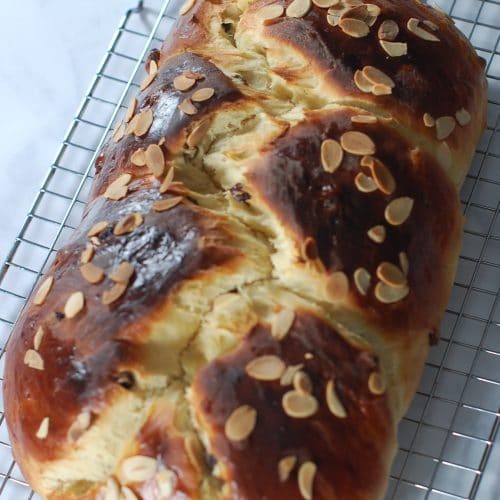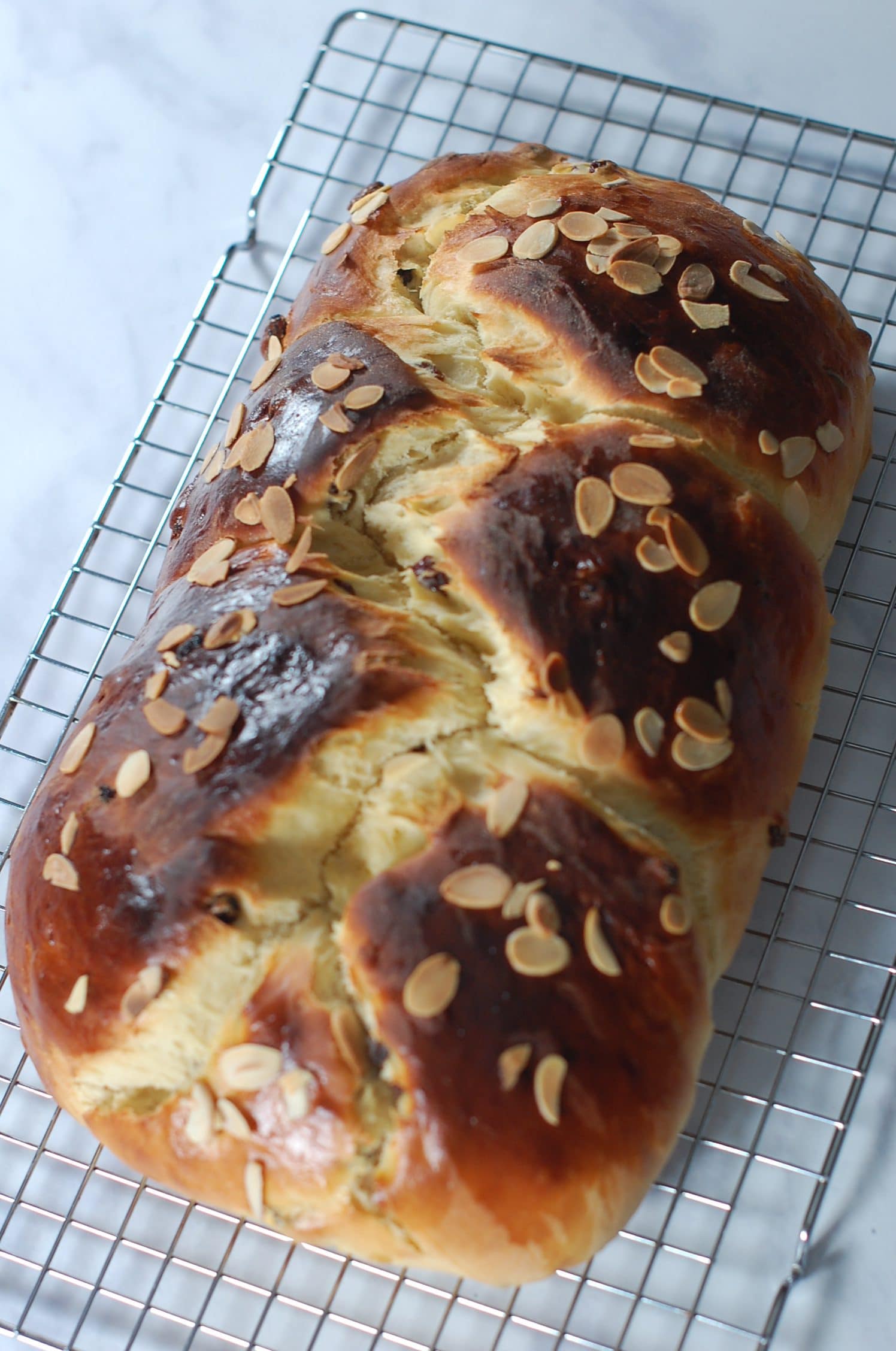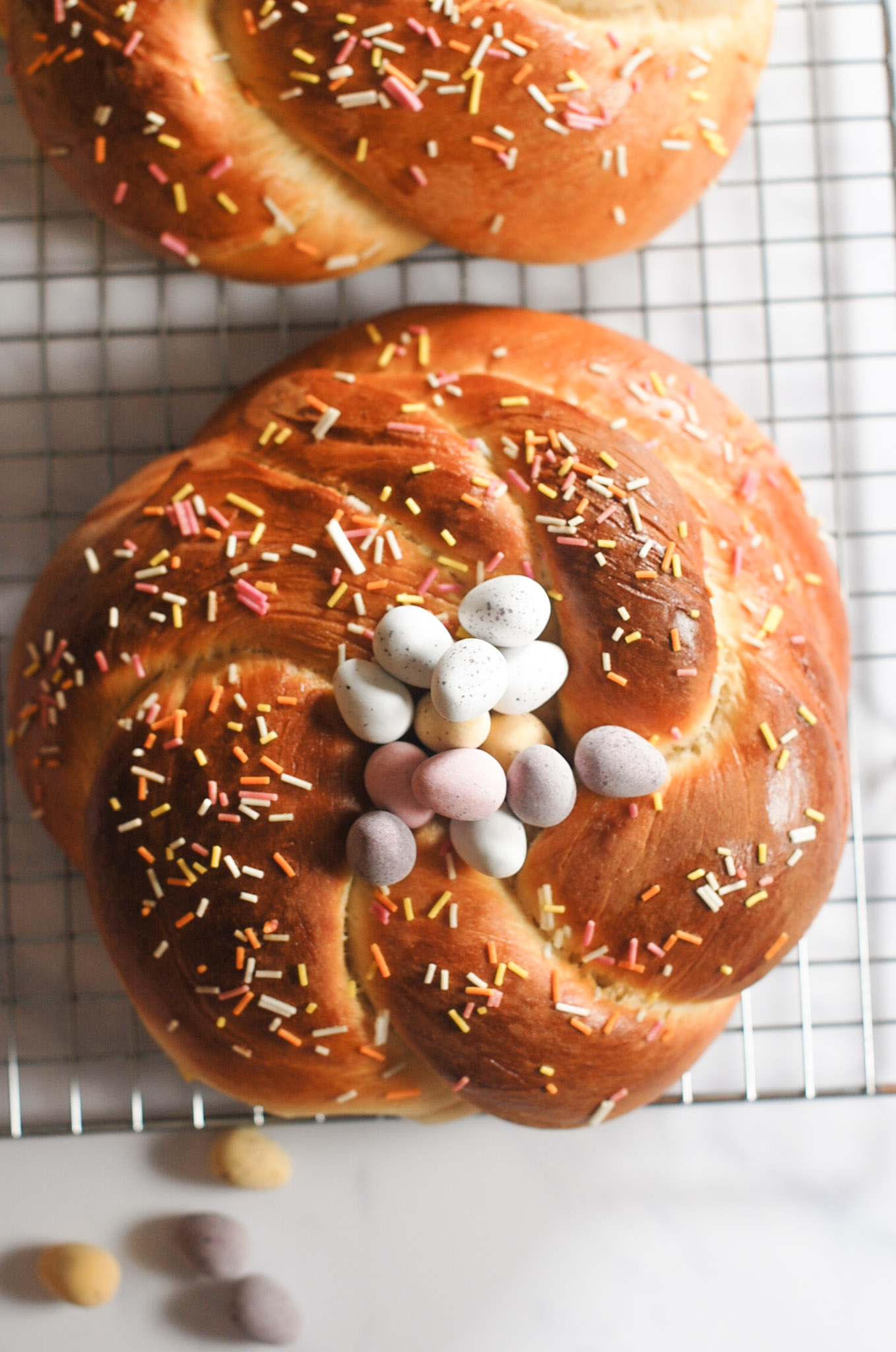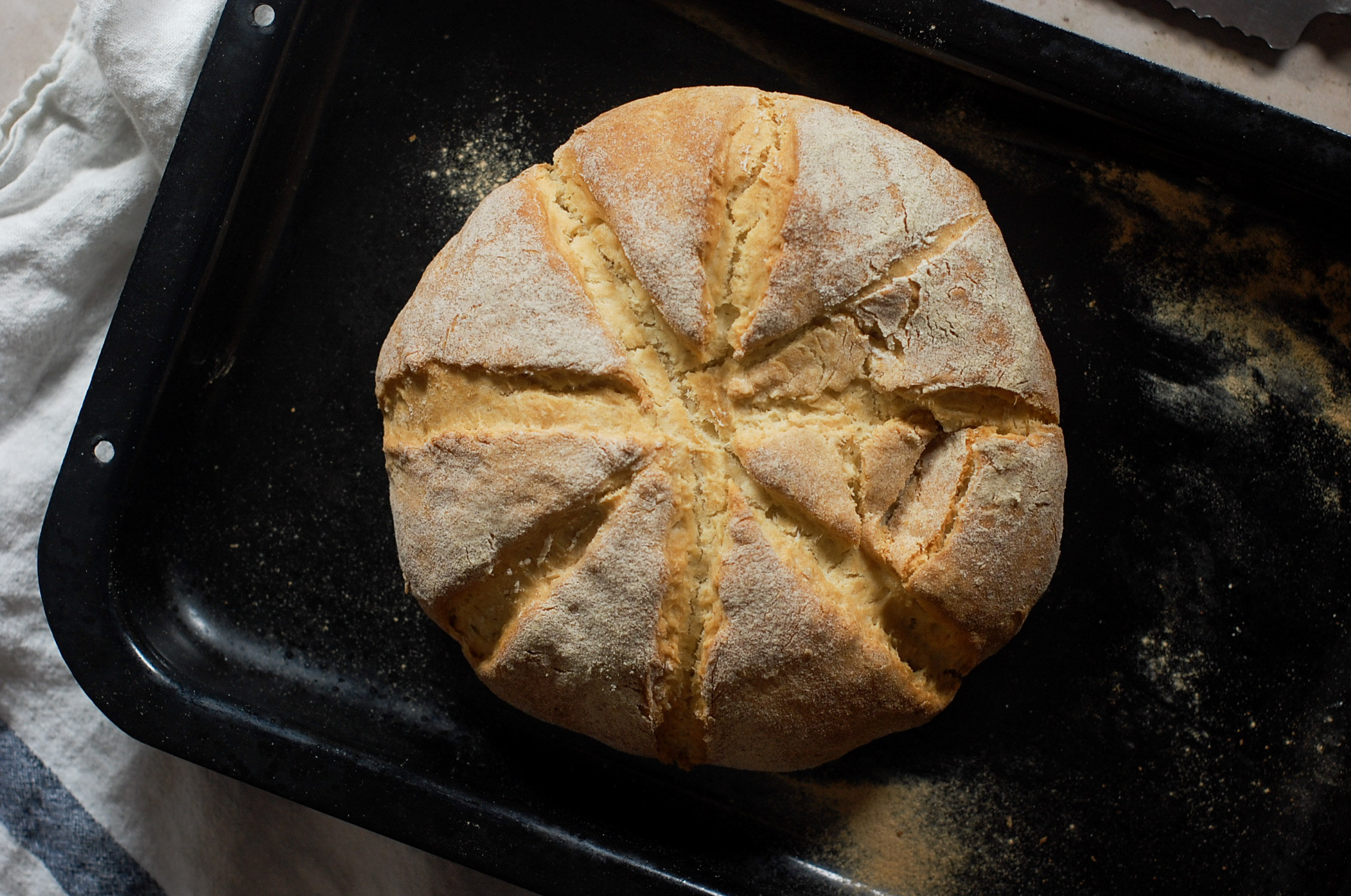Bulgarian Easter Bread (Kozunak) + Video
A deliciously soft tear and share bread filled with raisins soaked in lemon, traditionally made in Bulgaria. Kozunak, a.k.a Bulgarian Easter Bread is perfect served upon an Easter table amongst well-loved friends and family.
Traditionally made for Easter celebrations in Bulgaria, Kozunak is a brioche-like bread which is sometimes plaited and other times eaten as a loaf.
I found discovering this bread a real joy. The process is long (you have to wait twice for it to prove) but it’s easy to make and well-worth it. The raisins soaked in lemon juice really give it a lovely flavour. Your kitchen will end up smelling a lot like Christmas!
It reminded me of the Italian Easter bread (pane di pasqua) I made last year. Another one worth trying, if you’re a fan of a brioche-type loaf!
Ingredients needed
Scroll down to the recipe card for the exact quantities.
Yeast (dried, fast-action – anything ready to go).
Caster sugar – you’ll need it for the yeast but also for the bread dough.
Milk (warmed) – whole or semi – your call!
Eggs – and a lot of them!
Lemon (juice and zest).
Unsalted butter
Raisins
Plain flour
Flaked almonds
Egg & milk for egg wash (to glaze the bread).

Timings
Prep Time
20 mins
Prove/Cook time
30 mins + 3 hr 30 mins proving.
Total time
4 hrs 20 mins
Servings
4-5 people
How to bake Bulgarian Easter Bread
Step 1 – Activate the yeast: In a small bowl, mix the yeast with the warm milk and a tsp of sugar. Stir and leave to activate for 5 minutes.
Step 2 – Soak the mixed fruit: Add the dried fruit and lemon juice and zest to a bowl. Set it aside.
Step 3 – Make the dough: Whisk together the 200g of sugar with the 5 eggs until well combined. You can use a stand mixer with whisk attachment if easier. Add the milk/yeast mixture and the melted butter. Mix until combined.
Step 4 – Add the flour in thirds and mix until the dough comes together. It will appear sticky and that’s ok! Use a dough hook if using a stand mixer. Throw in the fruit and lemon juice and combine. If the dough appears too wet at this stage, add 50g extra flour and combine.
Step 5 – 1st prove: Place the dough into a well-oiled bowl and cover with cling film. Place in a warm area of the house and leave to prove until doubled in size. This could take up to 2 hours.
Step 6 – Knock back and knead: Knock back the dough once doubled in size by punching it down with your hands. You may want to flour your hands beforehand as the dough will be very sticky and get stuck to your hands! Knead the dough for 5 minutes on a floured surface.
Step 7 – Plaiting the dough (see video below for a visual demonstration): Cut your dough into 3 equal pieces. Roll each piece into a sausage-like shape (don’t worry about the length – you can make the sausages as long as you like (just not too thin or they might break!) I’d aim for at least 20cm. The main thing is that they are equal.
Place the pieces of dough side by side and join at the top. Plait the dough as you would plait hair: left piece over middle, right piece over middle and so and so forth. `
Step 8 – 2nd prove: Cover the plaited bread with a tea towel and leave to prove for 30 minutes more. Once the dough has noticeably proved, mix together your 1 egg and 2 tbsp of milk to make your egg wash. Brush the dough all over with the egg wash. Sprinkle on your flaked almonds.
Step 9 – Baking the bread: Bake in the oven (around 190°c/ 170°c fan) for 30-35 minutes. Cool on a wire rack for 10 minutes and then tear it apart to eat! Best served warm.
Equipment needed
Small bowl x 2
Measuring spoons
Stand mixer with bowl plus whisk and dough hook attachment (or a large bowl + hand whisk)
Small pan for melting the butter
Cling film
D-scraper for cutting dough (or a knife)
Tea towel
Pastry brush (I prefer the silicone ones as I find the wooden ones lose their hairs)
Wire rack
Kozunak Bread Recipe Video!
(coming soon!)
Frequently Asked Questions!
Where does Kozunak bread come from?
There are so many different types of Easter breads around Europe, all with lots of similarities. A lot of them contain fruit and a lot of them are brioche-like (light and fluffy texture). Eating this type of bread can be dated back to the Homeric Greek period but also the Romans (they were well-known to indulging in sweetened bread).
Is Kozunak gluten-free?
Unfortunately it is not due to the use of plain flour. You could try and replace with gluten-free flour or make something like this chocolate chip gluten-free brioche loaf from The Gluten Free Blogger and replace with lemon-soaked dried fruit?
Can I freeze brioche dough?
Yes you can freeze brioche dough before baking. After the first rise, knock back and shape into a ball. Wrap well with cling film and place in a Tupperware or as is. Freeze for up to a month. Defrost throughly and continue with shaping and second prove.
Tips for making Kozunak Bread
If you’re having trouble finding somewhere to prove your bread, here’s what you need to do: heat your oven at a low temperature (say around 30°c) and once up to temp, turn off. Leave your oven door open to let a lot of the heat out. You can place your dough in the oven to prove and it should provide enough warmth without being too hot to kill the yeast.

Kozunak (Bulgarian Easter Bread)
Equipment
- Small bowls x 2
- Measuring spoons
- Stand mixer with whisk and dough hook attachment (or a large bowl and hand whisk)
- Small pan
- Cling film
- D-scraper
- Tea towel
- Pastry brush
- Wire rack
Ingredients
Activating the yeast
- 7 g yeast dried, fast-action
- 1 tsp caster sugar
- 100 ml milk warmed (semi or whole)
The fruit
- 130 g dried fruit
- 1 lemon zest and juice
The dough
- 5 eggs
- 200 g caster sugar
- 700 g plain flour
- 60 g unsalted butter melted
- 1 tsp olive oil for oiling the bowl
- Handful flaked almonds
Egg wash
- 1 egg
- 2 tbsp milk semi or whole
Instructions
The prep
- In a small bowl, mix the yeast with the warm milk and a tsp of sugar. Stir and leave to activate for 5 minutes.
- Add the dried fruit and lemon juice and zest to a bowl. Set it aside.
Make the dough
- Whisk together the 200g of sugar with the 5 eggs until well combined. You can use a stand mixer with whisk attachment if easier. Add the milk/yeast mixture and the melted butter. Mix until combined.
- Add the flour in thirds and mix until the dough comes together. It will appear sticky and that's ok! Use a dough hook if using a stand mixer. Throw in the fruit and lemon juice and combine. If the dough appears too wet at this stage, add 50g extra flour and combine.
1st prove
- Place the dough into a well-oiled bowl and cover with cling film. Place in a warm area of the house and leave to prove until doubled in size. This could take up to 2 hours.
Kneading
- Knock back the dough once doubled in size by punching it down with your hands. You may want to flour your hands beforehand as the dough will be very sticky and get stuck to your hands! Knead the dough for 5 minutes on a floured surface.
Shaping the dough
- Cut your dough into 3 equal pieces. Roll each piece into a sausage-like shape (don't worry about the length – you can make the sausages as long as you like (just not too thin or they might break!) I'd aim for at least 20cm. The main thing is that they are equal. Place the pieces of dough side by side and join at the top. Plait the dough as you would plait hair: left piece over middle, right piece over middle and so and so forth.
2nd prove
- Cover the plaited bread with a tea towel and leave to prove for 30 minutes more. Once the dough has noticeably proved, mix together your 1 egg and 2 tbsp of milk to make your egg wash. Brush the dough all over with the egg wash. Sprinkle on your flaked almonds.
Baking the dough
- Bake in the oven (around 190°c/ 170°c fan) for 30-35 minutes. Cool on a wire rack for 10 minutes and then tear it apart to eat! Best served warm.
Notes
Nutrition
More sweetened bread recipes –
Italian Easter Bread (pane di pasqua)
African Fat Cakes (magwinya)







